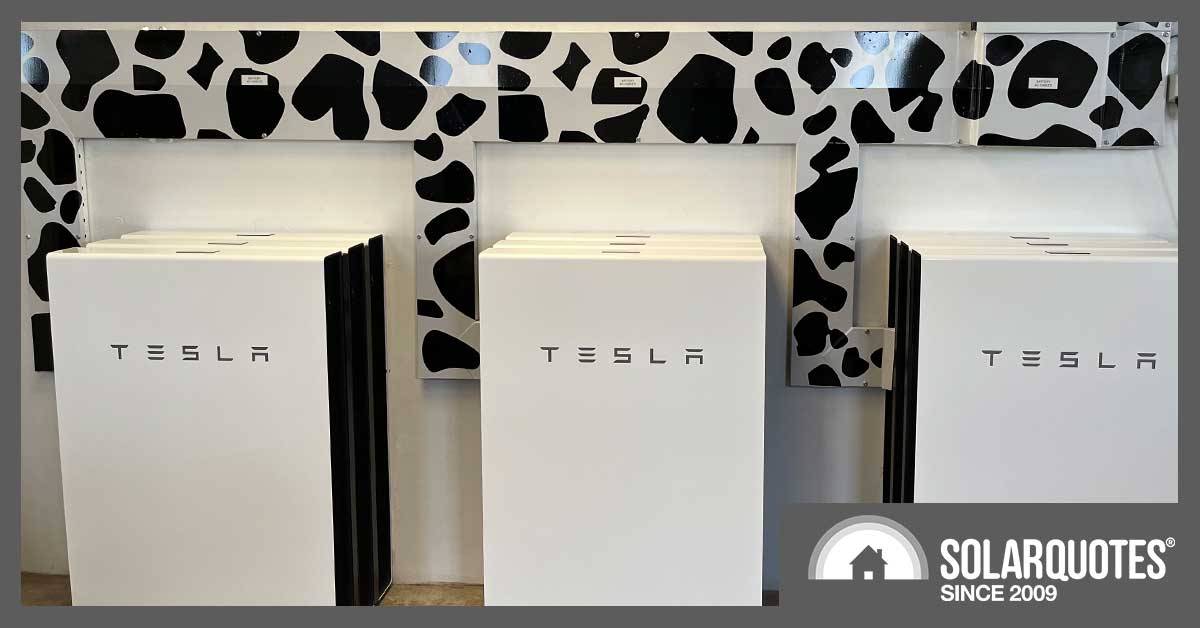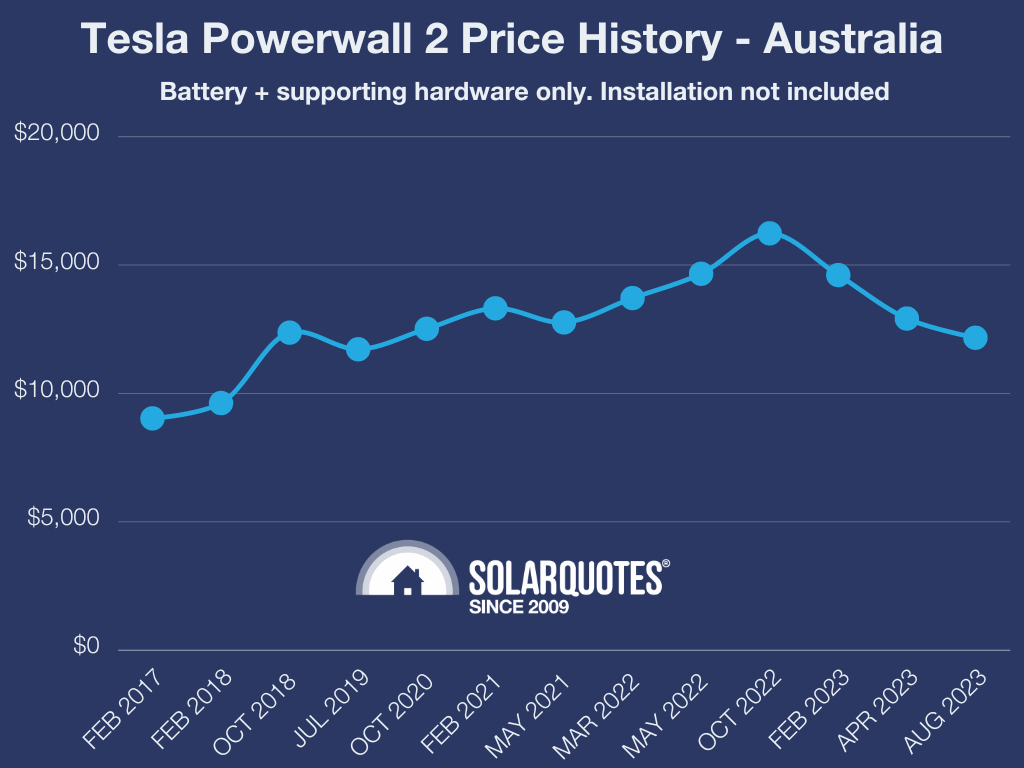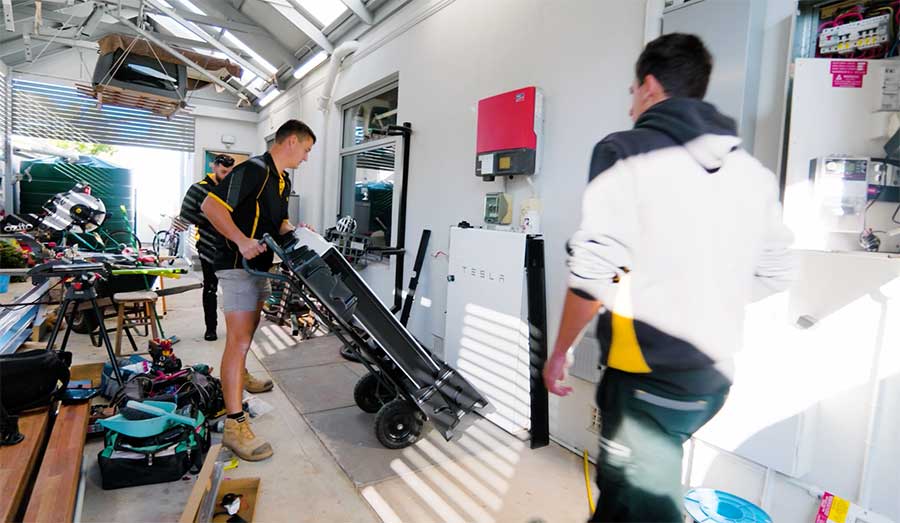
Udderly electrifying savings available on Powerwalls – but only if you moo-ve fast. Install: Platinum Solar Designs
Tesla has announced a $750 rebate for its Powerwall in Australia, a part of a global rebate push that includes the USA (US$500) and the UK (£350). Here’s a breakdown of what this means for prospective Australian Powerwall buyers.
Three Powerwall Price Drops In A Row
The Powerwall’s price has been on a rollercoaster ride in recent years. After the rebate, the cost drops to $12,150 – the lowest since July 2019 when it was priced at $11,700. Here’s a quick look at the price history:

Note: the most recent price point is after the $750 rebate has been claimed from Tesla
- Feb 2017: $9,000
- Feb 2018: $9,600
- Oct 2018: $12,350
- Jul 2019: $11,700
- Oct 2020: $12,500
- Feb 2021: $13,300
- May 2021: $12,750
- Mar 2022: $13,700
- May 2022: $14,650
- Oct 2022: $16,230
- Feb 2023: $14,599
- Apr 2023: $12,900
- Aug 2023: $12,150 (after Tesla rebate)
Battery Installation Deadline
To be eligible for the rebate, a Tesla Certified Installer must install the Powerwall by 31 December 2023. Be aware Australian solar installers are typically very busy at the end of the year as the Australian solar rebate (STC scheme) drops for systems installed after 31 December. So, move quickly if you want to take advantage of this offer.
Powerwall Cost Analysis
Expect a fully installed Tesla Powerwall to start at about $15,750 if it’s a simple installation (i.e. right next to your switchboard, single phase, no bollards). That’s $15,000 after the rebate. If adding a second Powerwall, expect to pay from $13,000 ($12,250 after rebate), due to no need for a second ‘gateway’ and a more straightforward installation.
Video Coming Next Week
If you are keen to add a second Powerwall, we’ve just finished editing a video of what’s involved. The second battery is for a South Australian customer taking advantage of SA’s ‘Solar Sponge Tariff’. He now fills his 2 Powerwalls with solar electricity and 8c-per-kWh grid electricity; riding through the brutal 75c-per-kWh evening peak every day and halving his hefty winter electricity bills while powering a spa, swimming pool and fish tank. Stay tuned for this video to drop on Monday.

Mounting a second Powerwall onto an existing one.
Rebate Eligibility And Details
Customers must order from Tesla Certified Installers and have their Powerwall(s) connected and registered by 31 December 2023. If you miss the install deadline, you miss the rebate. Once confirmed, Tesla will transfer the funds to the nominated bank account.
Final Thoughts
This isn’t a sales pitch, and I’m not here to sugarcoat the offer. The Powerwall rebate is a decent price reduction on a first or subsequent Powerwall. But be mindful of the end-of-year rush, and don’t leave it to the last minute.
For those in the market for more energy independence or those on a Time Of Use tariff looking to avoid the evening peak, I personally consider the Powerwall the best battery available. It just works, it’s compact, the backup is reliable, the app is a joy to use and the control software behind the scenes does a great job of minimising your electricity bill; especially as tariffs get more complex. So this offer from Tesla might just be worth considering.

 RSS - Posts
RSS - Posts



How do I apply for the $750 tesla rebate? Is there a commencement date as my Powerwall was installed early July 23
Thanks
Hi,
Can you connect a Powerwall V1 with the newer Powerwall V2/3?
The original installation was some 6 years ago.
Quite happy with performance over the years – only 1 tech required issue
The original Powerwall can’t connect to app and therefore can’t get any real data from it…
Also only has ½ the storage of today version and the more storage would be great with increased power supply charges
Thanks for any advice
Clearing stocks of PW2’s ready for the arrival of the PW3?
It will be great to see where the customer is buying his solar sponge grid electricity at 8c per kWh. This will make it extremely affordable to run the cheap and reliable resistive hot water service rather than pay for a high priced heat pump that will only save minimal $ in power costs,… and the resistive HWS can make more use of daytime oversupply of power to help to stabilise the grid. A big win all round (except for those who were blindsided by energy efficiency claims rather than cost efficiency)
Hi Tim, would you mind sharing more info on this topic, I was considering a new heat pump.
“It will be great to see where the customer is buying his solar sponge grid electricity at 8c per kWh.”
You seem to be ignoring the very obvious fact that the trend in price of grid power is up not down.
https://www.ioenergy.com.au/plans
Damn! I jumped the gun and got my Powerwall installed 3 weeks ago – managed to get a $500 end of financial year deal on it though, guess I can’t complain too much!
I wish I could justify a Powerwall, but given the rates we have in Queensland, it’s just impossible to do so. It’s a 10-15 year payback, and that’s just never going to fly unfortunately.
Is that assuming a single full cycle every 24 hour period over the course of 10-15 years?
According to my figures you need roughly 39,000 kWh or just over 2,800 cycles, or slightly less than 8 years for a Tesla battery to pay for itself.
I’m not factoring in lost FiT revenue, efficiency loss, battery degradation, or lost interest on spent capital, but that’s still a radically different figure to 10-15 years!!!
For those who use very little grid power <10 kWh per day, especially those using <5 kWh per day, the cost per battery kWh is higher or significantly higher than the cost of grid power.
On a side note, the Tesla review link in the article notes that it doesn't support 3 phase, doesn't support a generator, and doesn't support off-grid use, all critical issues in an age of increasingly unreliable power, increasingly expensive power, and 3 phase houses becoming increasingly common. But if the Tesla is a good fit for your situation go for it.
Aren’t you presupposing that every kWh of battery usage is done during the evening peak with your calculations?
FIT is roughly 20% of the peak charge, so not counting for it once again produces a result that is out by around 20% so closer to 10 years assuming the entire battery replaces peak usage, which for most people is totally impractical.
Including the cost of capital the payback time blows out to closer to never than any range of years since it far exceeds the useful life of the battery.
Harry,
No I’m assuming battery usage is trickle use throughout the dusk-dawn period and a flat rate. FiT was closer to 15.6% than 20% in my figures. That still pushes the 8 years closer to the 10 year mark of course. Add in power lost to inefficiency plus shrinkage through battery degradation and that repayment period rises. But power will continue to rise. On the other hand if it’s a 20% rise each year for the foreseeable future, and it could be more, then the repayment period shrinks. Ultimately it’s a gamble.
SQ’s new article here (https://www.solarquotes.com.au/blog/solar-batteries-lifespan/) suggests a battery life of 12-17 years depending on temperatures and treatment but I prefer the 10 year figure as that’s all that’s covered by a warranty, at least I think Tesla has a 10 year one? I know not all do.
Your repayment period will vary enormously depending on the rates you pay, if you have time-of-use tariffs, and obviously how much you use.
I believe most people in Australia, based on the use stats I’ve seen, will struggle to even break even with solar batteries as they are priced right now, and many would lose money long term. Even if you do break even, you’re effectively paying for ten years upfront electricity use with little to no benefit.
Of course there are benefits to batteries, like backup power, however many inverter/battery combinations can’t even do this right now.
I would love to be able to justify a battery, but no matter how hard I try it just seems like a huge con right now. Add it to the flood of solar installers promising their customers “zero dollar bills” (which is a ridiculous lie) and the industry as a whole isn’t looking very trustworthy right now, imho.
Lachlan, I agree that most Australians “will struggle to even break even with solar batteries as they are priced right now” especially those with low grid use.
SQ had an article a while back that listed price ranges for 5 kWh, 10 kWh and 15 kWh batteries – including installation if I recall correctly. I broke those down to price per kWh – assuming 1 full cycle per 24 hour period, no battery degradation, and 10 years of use. For the 15 kWh batteries you were looking at 32.9-27.4c per kWh, slightly better than current prices in most states – and far better than the cost of electricity in SA, but for the 5 kWh size you’re looking at 49.3-38.4c per kWh!!! Part of that range is more expensive than current SA grid prices!!!
Backup power is nice, yes, but if it doesn’t kick in straight away you still get a blackout, albeit a brief one, which messes stuff up. And many batteries aren’t designed for 3 phase houses, which complicates things and increases the cost. I periodically look at it but for now just can’t justify the cost.
Neil
Over 12 months my battery averages around 7kwhs per day discharge into the house.
Other people may have a higher average discharge.
I am thinking my battery will take 22 years to break even, and the battery will not last that long
Neil, that is along time to get payback,…and I suppose that does not cover interest cost either which would make it more than 2x the cost over that time frame? Your comment shows that it is best to use PV when available.
A much smaller investment in timers and power diverters to run the hot water, pool pump and chest freezers etc pay huge dividends with paybacks in only a couple of years. We run 3 freezers from 8;30 to 5pm (later in summer heat with long days) on plug-in-timers, and the cost of the lost FIT on 900kWh per year at 6c is only $54 per year for the three of them. (The freezer thermostat always turn off before the timer turns off). I’m looking at Power Diverter Australlia new power diverter (with extra features), but just our basic hot water heating power will be 48cents per day. (8kWh/day x 6cent FIT forgone). Of course if the FIT gets lower it will be even better to self consume.
Tim
I know it does not quite work out like this, but
the cost of power from the grid is 30cents per kilowatt hour
@7kwh per day @30cents means a saving of $2.10 per day
Since the battery insatlation cost $17500
@$2.10 per day I break even at 8333 days
8333 days is 22.8 years
But remeber the electricity cost saving is reinvested over the years and the price of electricity changes
Finn, I had a Tesla PW installed in July, can I get the rebate? If so, where do I go to claim. Thanks Carolyn
Is it really all about payback?
What’s the payback period on a pool? boat? holiday? Mobile phone? laptop?
Value is another way of looking at it.
Some important values are not monetary.
I choose to invest in a battery but financial payback is only one consideration.
What are your other considerations?
If you have endless spare cash, then perhaps you can justify $15,000+ on a shiny toy that supplies electricity at prices significantly higher than even the current high grid prices. I doubt that most people are there with you.
I love my solar system, but at current feed in rates even that would be hard to justify these days.
Am I misreading this?
PW only $10,400 minus rebate = $$9,650 plus gateway $1700
It is the Au site. No VPP requirement?
https://www.tesla.com/en_AU/powerwall/get